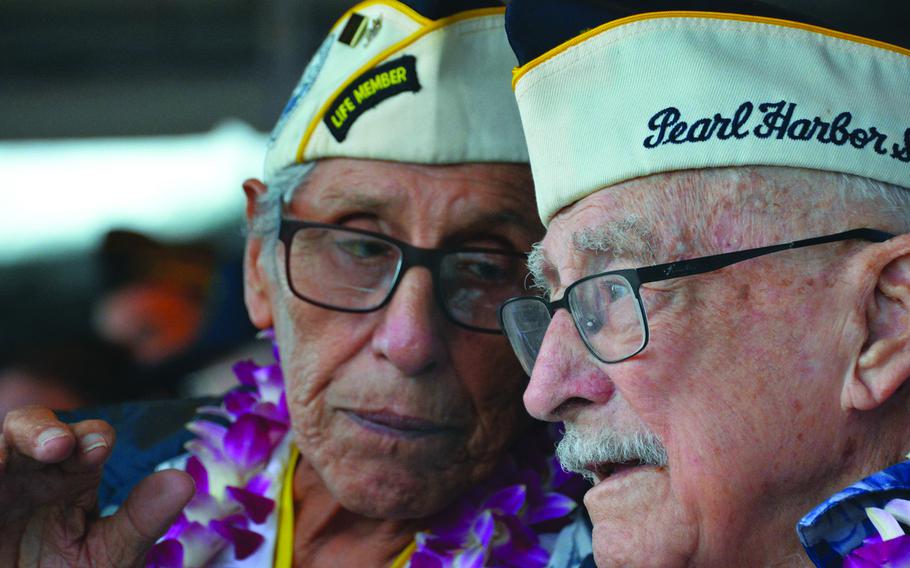
Robert Fernandez, left, chats with fellow Pearl Harbor survivor George Keene at the Pearl Harbor Visitor Center, Dec. 7, 2018, before a ceremony commemorating the 77th anniversary of the surprise attack by Japan in 1941. (Wyatt Olson/Stars and Stripes)
Robert Fernandez was a 17-year-old boy with a sense of wanderlust when he enlisted in the Navy in August 1941.
Four months later he was working as a cook aboard the USS Curtiss docked at Pearl Harbor, Hawaii, the morning of the cataclysmic Japanese surprise attack on Dec. 7, 1941.
“I just thought I was gonna go dancing all the time, have a good time, see the world,” Fernandez recalled in a 2016 interview. “What’d I do? I got caught in the war.”
Fernandez, who died Wednesday at age 100 in Lodi, Calif., was among the hundreds of service members who survived the attack. His death leaves barely more than a dozen Pearl Harbor veterans still living.

Pearl Harbor and WWII veteran Robert Fernandez speaks to a reporter at the Pearl Harbor Visitor Center, Dec. 7, 2018, before a ceremony commemorating the 77th anniversary of the surprise attack by Japan in 1941. (Justin Pacheco/U.S. Navy)
Fernandez had planned on attending the annual commemoration of the attack held each year at the Pearl Harbor National Memorial in Hawaii, but a sudden downturn in his health forced him to cancel at the last minute.
His photo and short bio had been included in the ceremony’s program, along with those of the only other two veterans of the attack who attended.
His death was announced in a post on the social platform X by Pacific Historic Parks.

The seaplane tender USS Curtiss burns during Japan's surprise attack on Pearl Harbor, Hawaii, Dec. 7, 1941. (U.S. Navy)
Fernandez was busying himself in the ship’s mess the morning of Dec. 7, 1941, anticipating liberty later in the day.
When the ship’s alarms when off, he raced up to the deck of the Curtiss, a seaplane tender, Fernandez recalled in 2016 for the Library of Congress’s Veterans History Project.
A plane flew past him, so close he felt he could reach out and touch it.
“And the pilot didn’t even look at me; he just kept on going,” Fernandez said. “I just run right home to my battle station.”
“All I could see was a red ball,” he said, referring to the rising sun emblem on the plane.
He was scared.
“My knees were knocking,” he said. “I seen a couple guys on the deck just praying and praying and praying.”
Fernandez’ battle station was three decks below, where he was sealed up “like they do in a submarine,” he said. His job was to pass ammunition to the gunners.
The Curtiss was one of few ships that managed to get underway during the attack. The ship’s crew sighted the periscope of a Japanese midget submarine in the harbor and fired upon it.
Shipboard gunners hit a Japanese plane, which crashed into the Curtiss. Minutes later, a Japanese dive bomber struck the ship and damaged several decks.
Twenty-one crew members of the Curtiss died that day, with many more than that wounded.
Fernandez served aboard the ship for the rest of the war. It saw service during the battles at Midway, Guadalcanal and the Solomon Islands.
He was discharged from the Navy in 1947.